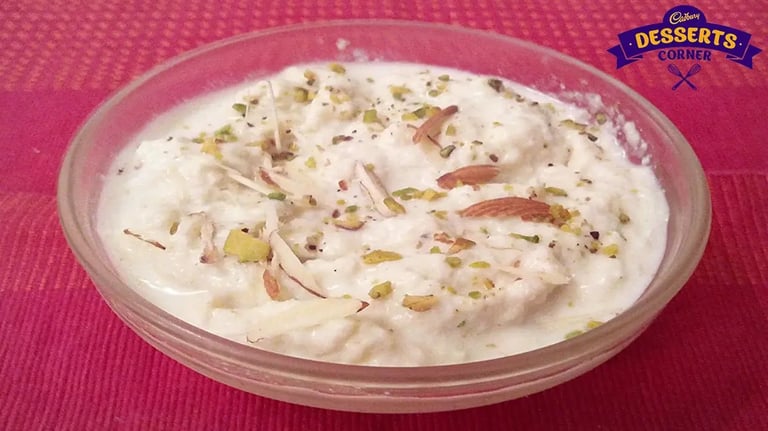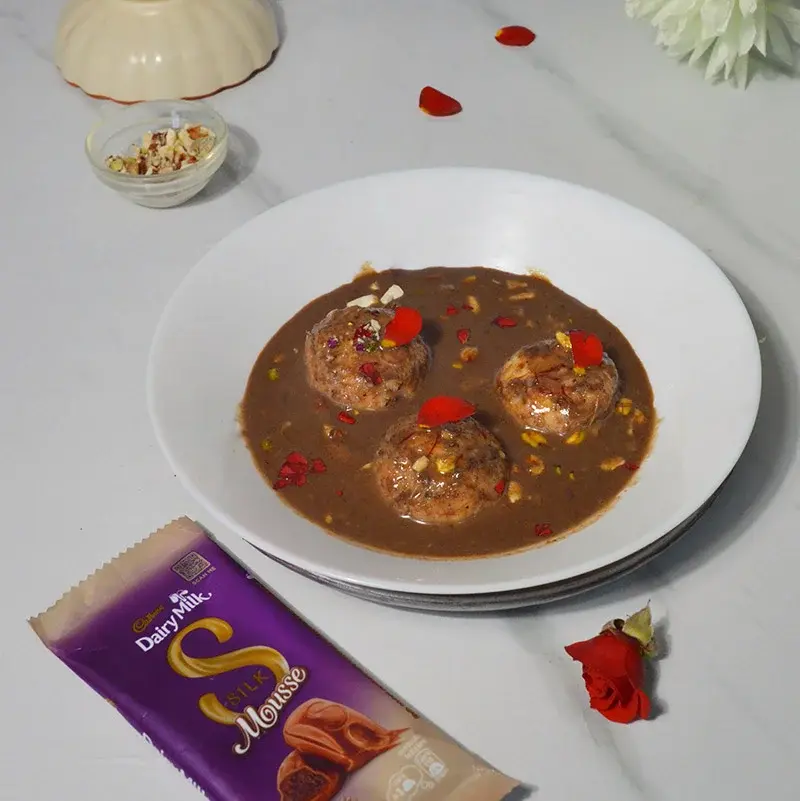Rabri is popular all over the country, and for good reason. It's delicious. So here’s a dive into its history and a recipe to follow along.

Rabri is popular all over the country, and for good reason. It's delicious. So here’s a dive into its history and a recipe to follow along.
Rabri is a rich and creamy milk-based dessert, made by boiling milk on low heat for a long enough time that it becomes dense and thick. This also gives the rabri a specific texture, smooth and coating the tongue with its subtle sweetness.
It is generally agreed that rabri was invented in Mathura, the land of Lord Krishna. The Yadavs, descendants of the Lord, are credited with creating the layered dessert, their creation inspired by their forefather’s love for milk based products. The important place the dish holds in the area’s local culture is reflected in the story surrounding the curtains at the neighboring Vrindavan’s Banke Bihari temple.
The story goes that a Rajasthani princess would visit the temple every day with rabri as an offering to the Lord. Her love for him would cause tears in her eyes, and she would look at him with deep love and respect. Mesmerized by her love for him, Bihariji followed her home one day. The temple, established by Tansen’s guru Swami Haridas, was frantic at seeing him missing and a search began to bring him back to the temple. He was coerced back to the temple after much effort and rabri offering. From that day, a curtain was placed between him and his devotees, so he wouldn't follow another loving devotee out of the temple.

Another story comes from Rajasthan, where around 166 years back, a family earned fame in Jaipur. In 1857, Parmanand Jain, a wrestler, founded the Mahaveer Rabri Bhandar, a place where he sold sweet dishes. Before he started the shop, Jain worked as a cook in the royal kitchen. He also sold milk, curd and mawa on the side. Once, when Jai was slow boiling milk, he accidentally reduced it in a way that he had made rabri. He invited his friends to taste it, who were all impressed with his creation. It soon became a mainstay and special occasions and royal feasts. That’s how the shop came to be. Today, the shop sources around 1,000 liters of milk every morning, which is boiled and stored without refrigeration, and then used to cook about 150 kgs of rabri throughout each day. Among the people they’ve served food to are Lata Mangeshkar, Dara Singh and Bhairaon Singh Shekhawat, the former chief minister of Rajasthan.
From UP and Rajasthan, when rabri reaches Varanasi, Maharashtra and other places, slight variations emerge in the dish. Additions like dry fruits, khoya and saffron were made and the milk consistency differs everywhere depending on availability and type of milk being used. Its cousin basundi was also invented, which is popular along the west coast of the country.
On the opposite end of the country, rabri also reached Bengal soon enough. In the 1400 text Mangalkabyas one finds a mention of the rabri. The text Tales of Sri Chaitanya also mentions the dish. In Kolkata, non-Bengali salesmen carried rabri on their backs, popularizing the dessert all over the city. As a food writer recalls, “The Tiwaris and Sharmas taught the Bengali how to fall in love with the sweet”.

A Bengali village, nicknamed Rabrigram, roughly 90 minutes from Kolkata, consists of around 50 families, all making rabri. Since a cow gives, on average, 7 liters of milk a day, and most families have cowsheds, they end up producing over 2 kgs of rabri. Thirty years ago, the excess milk of the village would get wasted. But one of the residents returned with the knowledge of how to make rabri and started supplying it to sweet shops. Over time, the entire village started doing the same.
Today, rabri is often eaten on its own as well as paired with other desserts. During the summer, mango rabri is a particularly popular dish. Rabri is also paired with dishes like jalebi, malpua and shahi tukda.

Here’s a simple rabri recipe.
Ingredients:
- 1.25 l whole milk
- 3 tbsp sugar
- ½ tsp cardamom powder
- Pinch of saffron strands
- 1 tsp rose water
- 2 tbsp almonds
- 2 tbsp pistachios
Instructions:
- Take milk in a kadai or pan and heat on low to medium heat till the milk starts to froth or form a layer of clotted cream (malai) on top.
- With a spatula, gently bring the malai towards the side of the pan and stick it to the pan. Repeat this process, and also keep stirring occasionally.
- Once the milk reduces to half, add the sugar as per your taste preferences.
- Then add the crushed saffron strands and cardamom powder. Stir gently.
- When the milk has reduced to ¼ of its original quantity, turn off the heat.
- Scrape off the entire cream layer as well as dried milk solids and add into the thickened milk and stir gently.
- Add the sliced almonds, pistachios and rose water and stir gently.
- Garnish with nuts and serve warm or chilled.
More Like This
Popular Articles





Trending Web Stories
Curated Recipes
















